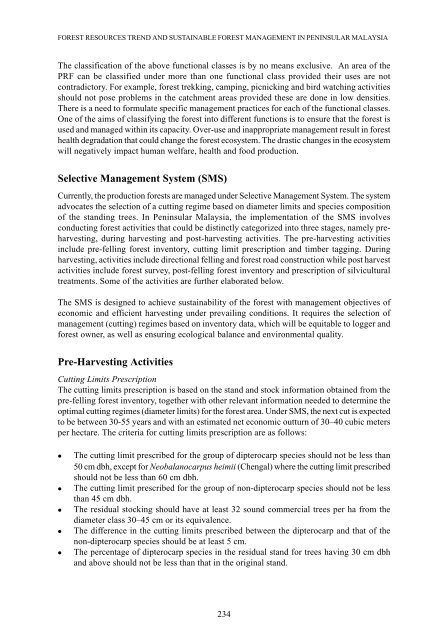o_19ko2dt161ng2j4e1tgnoqv1s45a.pdf
You also want an ePaper? Increase the reach of your titles
YUMPU automatically turns print PDFs into web optimized ePapers that Google loves.
FOREST RESOURCES TREND AND SUSTAINABLE FOREST MANAGEMENT IN PENINSULAR MALAYSIA<br />
The classification of the above functional classes is by no means exclusive. An area of the<br />
PRF can be classified under more than one functional class provided their uses are not<br />
contradictory. For example, forest trekking, camping, picnicking and bird watching activities<br />
should not pose problems in the catchment areas provided these are done in low densities.<br />
There is a need to formulate specific management practices for each of the functional classes.<br />
One of the aims of classifying the forest into different functions is to ensure that the forest is<br />
used and managed within its capacity. Over-use and inappropriate management result in forest<br />
health degradation that could change the forest ecosystem. The drastic changes in the ecosystem<br />
will negatively impact human welfare, health and food production.<br />
Selective Management System (SMS)<br />
Currently, the production forests are managed under Selective Management System. The system<br />
advocates the selection of a cutting regime based on diameter limits and species composition<br />
of the standing trees. In Peninsular Malaysia, the implementation of the SMS involves<br />
conducting forest activities that could be distinctly categorized into three stages, namely preharvesting,<br />
during harvesting and post-harvesting activities. The pre-harvesting activities<br />
include pre-felling forest inventory, cutting limit prescription and timber tagging. During<br />
harvesting, activities include directional felling and forest road construction while post harvest<br />
activities include forest survey, post-felling forest inventory and prescription of silvicultural<br />
treatments. Some of the activities are further elaborated below.<br />
The SMS is designed to achieve sustainability of the forest with management objectives of<br />
economic and efficient harvesting under prevailing conditions. It requires the selection of<br />
management (cutting) regimes based on inventory data, which will be equitable to logger and<br />
forest owner, as well as ensuring ecological balance and environmental quality.<br />
Pre-Harvesting Activities<br />
Cutting Limits Prescription<br />
The cutting limits prescription is based on the stand and stock information obtained from the<br />
pre-felling forest inventory, together with other relevant information needed to determine the<br />
optimal cutting regimes (diameter limits) for the forest area. Under SMS, the next cut is expected<br />
to be between 30-55 years and with an estimated net economic outturn of 30–40 cubic meters<br />
per hectare. The criteria for cutting limits prescription are as follows:<br />
• The cutting limit prescribed for the group of dipterocarp species should not be less than<br />
50 cm dbh, except for Neobalanocarpus heimii (Chengal) where the cutting limit prescribed<br />
should not be less than 60 cm dbh.<br />
• The cutting limit prescribed for the group of non-dipterocarp species should not be less<br />
than 45 cm dbh.<br />
• The residual stocking should have at least 32 sound commercial trees per ha from the<br />
diameter class 30–45 cm or its equivalence.<br />
• The difference in the cutting limits prescribed between the dipterocarp and that of the<br />
non-dipterocarp species should be at least 5 cm.<br />
• The percentage of dipterocarp species in the residual stand for trees having 30 cm dbh<br />
and above should not be less than that in the original stand.<br />
234



